Analysis of Unilever's Cash Flow Statement (Financial Accounting)
VerifiedAdded on 2022/12/15
|9
|1890
|398
Report
AI Summary
This report provides a comprehensive analysis of Unilever's cash flow statement, focusing on the years 2017 and 2018. It examines the three main sections: operating activities, investing activities, and financing activities, highlighting the key components and their impact on the company's cash flow. The analysis includes a detailed breakdown of the items contributing to cash inflows and outflows within each section, such as operating profit, depreciation, changes in working capital, purchase and disposal of assets, and financing activities like dividend payments and share repurchases. The report also compares the cash flow trends between the two years, identifying the reasons behind any increases or decreases in cash flow. Furthermore, it contrasts the cash flow statement with the income statement, explaining the fundamental differences in their objectives and the treatment of various financial items like depreciation. The conclusion assesses the overall financial health of Unilever based on its cash flow performance, providing insights into its liquidity and solvency.
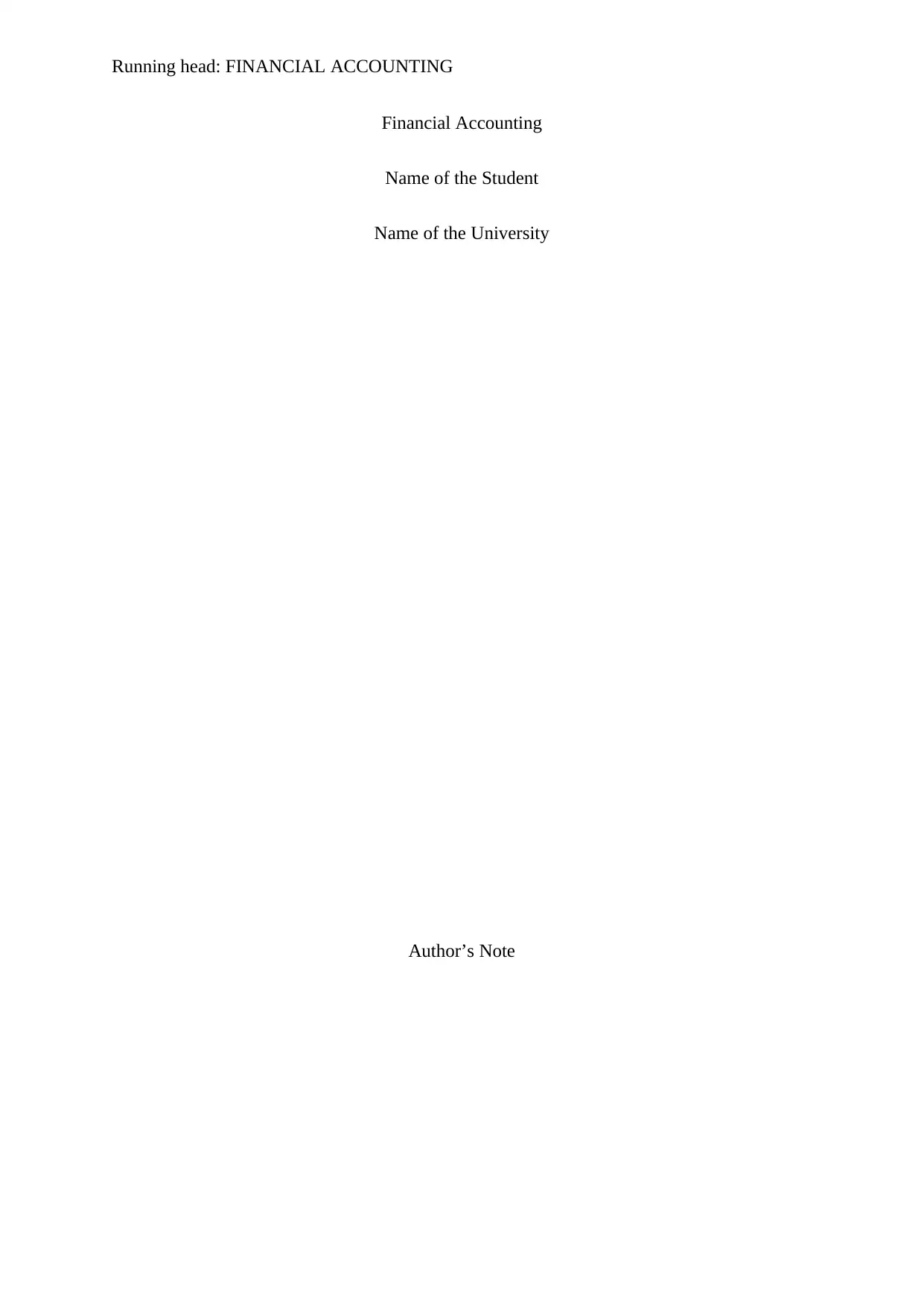
Running head: FINANCIAL ACCOUNTING
Financial Accounting
Name of the Student
Name of the University
Author’s Note
Financial Accounting
Name of the Student
Name of the University
Author’s Note
Paraphrase This Document
Need a fresh take? Get an instant paraphrase of this document with our AI Paraphraser
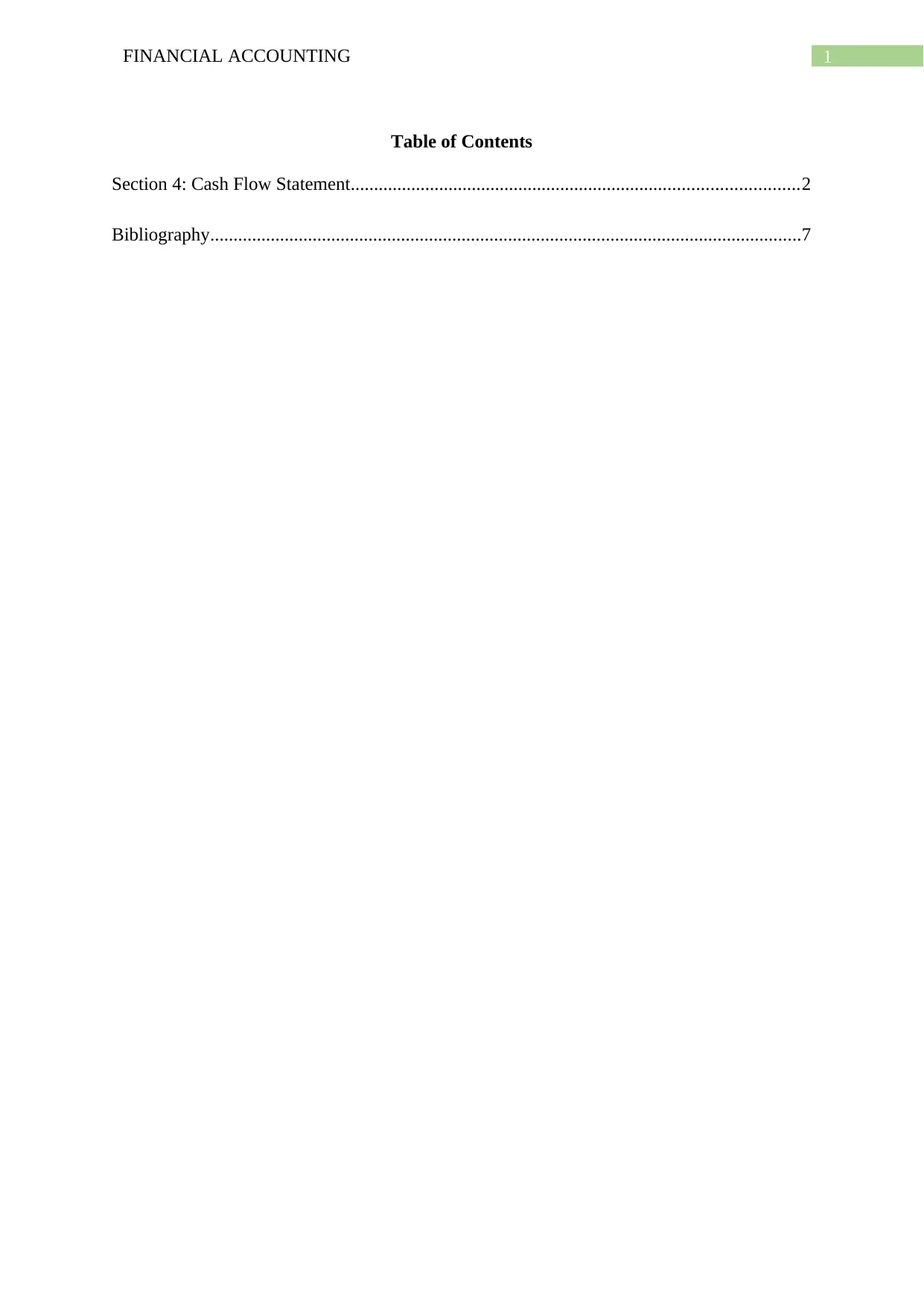
1FINANCIAL ACCOUNTING
Table of Contents
Section 4: Cash Flow Statement................................................................................................2
Bibliography...............................................................................................................................7
Table of Contents
Section 4: Cash Flow Statement................................................................................................2
Bibliography...............................................................................................................................7
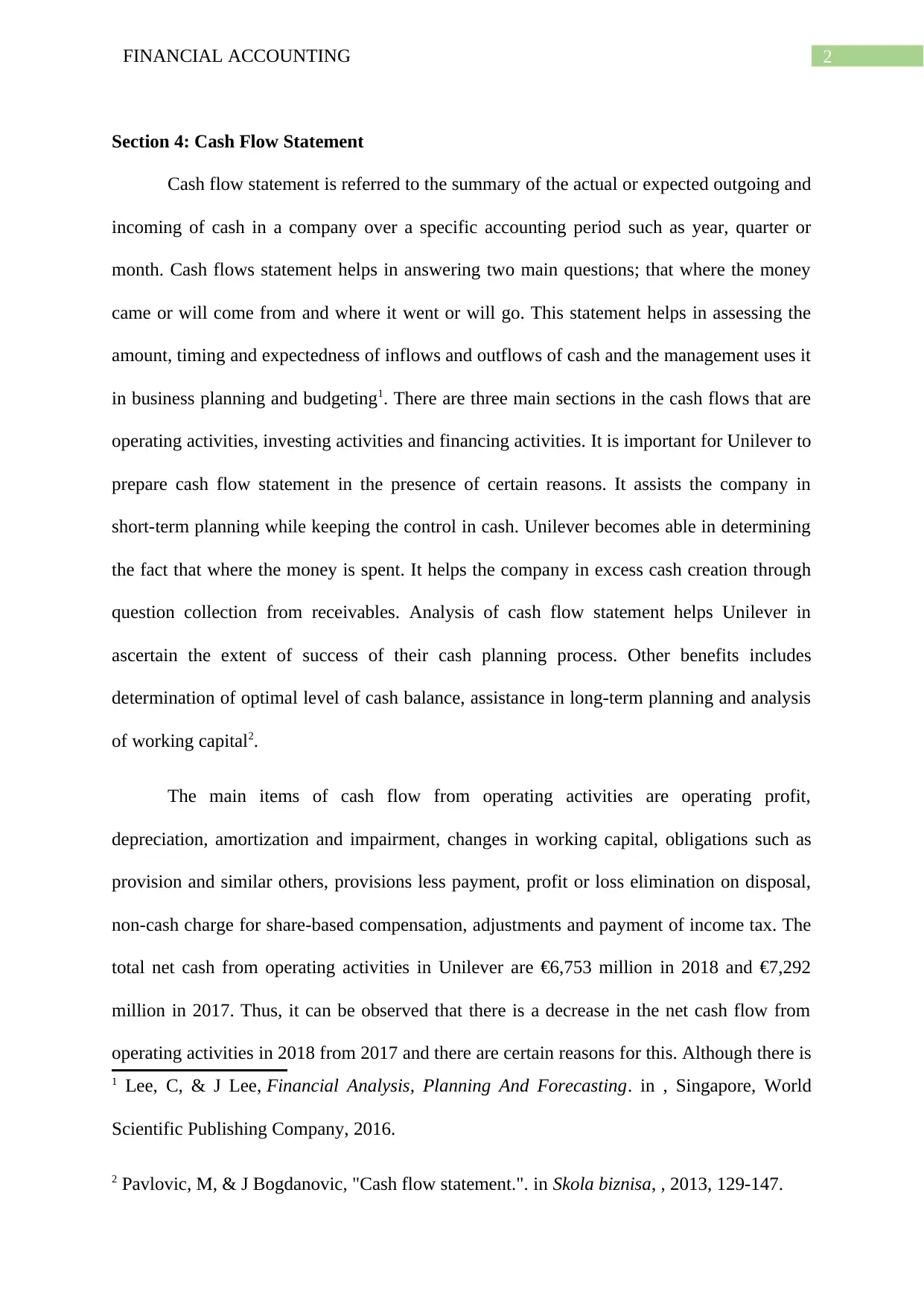
2FINANCIAL ACCOUNTING
Section 4: Cash Flow Statement
Cash flow statement is referred to the summary of the actual or expected outgoing and
incoming of cash in a company over a specific accounting period such as year, quarter or
month. Cash flows statement helps in answering two main questions; that where the money
came or will come from and where it went or will go. This statement helps in assessing the
amount, timing and expectedness of inflows and outflows of cash and the management uses it
in business planning and budgeting1. There are three main sections in the cash flows that are
operating activities, investing activities and financing activities. It is important for Unilever to
prepare cash flow statement in the presence of certain reasons. It assists the company in
short-term planning while keeping the control in cash. Unilever becomes able in determining
the fact that where the money is spent. It helps the company in excess cash creation through
question collection from receivables. Analysis of cash flow statement helps Unilever in
ascertain the extent of success of their cash planning process. Other benefits includes
determination of optimal level of cash balance, assistance in long-term planning and analysis
of working capital2.
The main items of cash flow from operating activities are operating profit,
depreciation, amortization and impairment, changes in working capital, obligations such as
provision and similar others, provisions less payment, profit or loss elimination on disposal,
non-cash charge for share-based compensation, adjustments and payment of income tax. The
total net cash from operating activities in Unilever are €6,753 million in 2018 and €7,292
million in 2017. Thus, it can be observed that there is a decrease in the net cash flow from
operating activities in 2018 from 2017 and there are certain reasons for this. Although there is
1 Lee, C, & J Lee, Financial Analysis, Planning And Forecasting. in , Singapore, World
Scientific Publishing Company, 2016.
2 Pavlovic, M, & J Bogdanovic, "Cash flow statement.". in Skola biznisa, , 2013, 129-147.
Section 4: Cash Flow Statement
Cash flow statement is referred to the summary of the actual or expected outgoing and
incoming of cash in a company over a specific accounting period such as year, quarter or
month. Cash flows statement helps in answering two main questions; that where the money
came or will come from and where it went or will go. This statement helps in assessing the
amount, timing and expectedness of inflows and outflows of cash and the management uses it
in business planning and budgeting1. There are three main sections in the cash flows that are
operating activities, investing activities and financing activities. It is important for Unilever to
prepare cash flow statement in the presence of certain reasons. It assists the company in
short-term planning while keeping the control in cash. Unilever becomes able in determining
the fact that where the money is spent. It helps the company in excess cash creation through
question collection from receivables. Analysis of cash flow statement helps Unilever in
ascertain the extent of success of their cash planning process. Other benefits includes
determination of optimal level of cash balance, assistance in long-term planning and analysis
of working capital2.
The main items of cash flow from operating activities are operating profit,
depreciation, amortization and impairment, changes in working capital, obligations such as
provision and similar others, provisions less payment, profit or loss elimination on disposal,
non-cash charge for share-based compensation, adjustments and payment of income tax. The
total net cash from operating activities in Unilever are €6,753 million in 2018 and €7,292
million in 2017. Thus, it can be observed that there is a decrease in the net cash flow from
operating activities in 2018 from 2017 and there are certain reasons for this. Although there is
1 Lee, C, & J Lee, Financial Analysis, Planning And Forecasting. in , Singapore, World
Scientific Publishing Company, 2016.
2 Pavlovic, M, & J Bogdanovic, "Cash flow statement.". in Skola biznisa, , 2013, 129-147.
⊘ This is a preview!⊘
Do you want full access?
Subscribe today to unlock all pages.

Trusted by 1+ million students worldwide
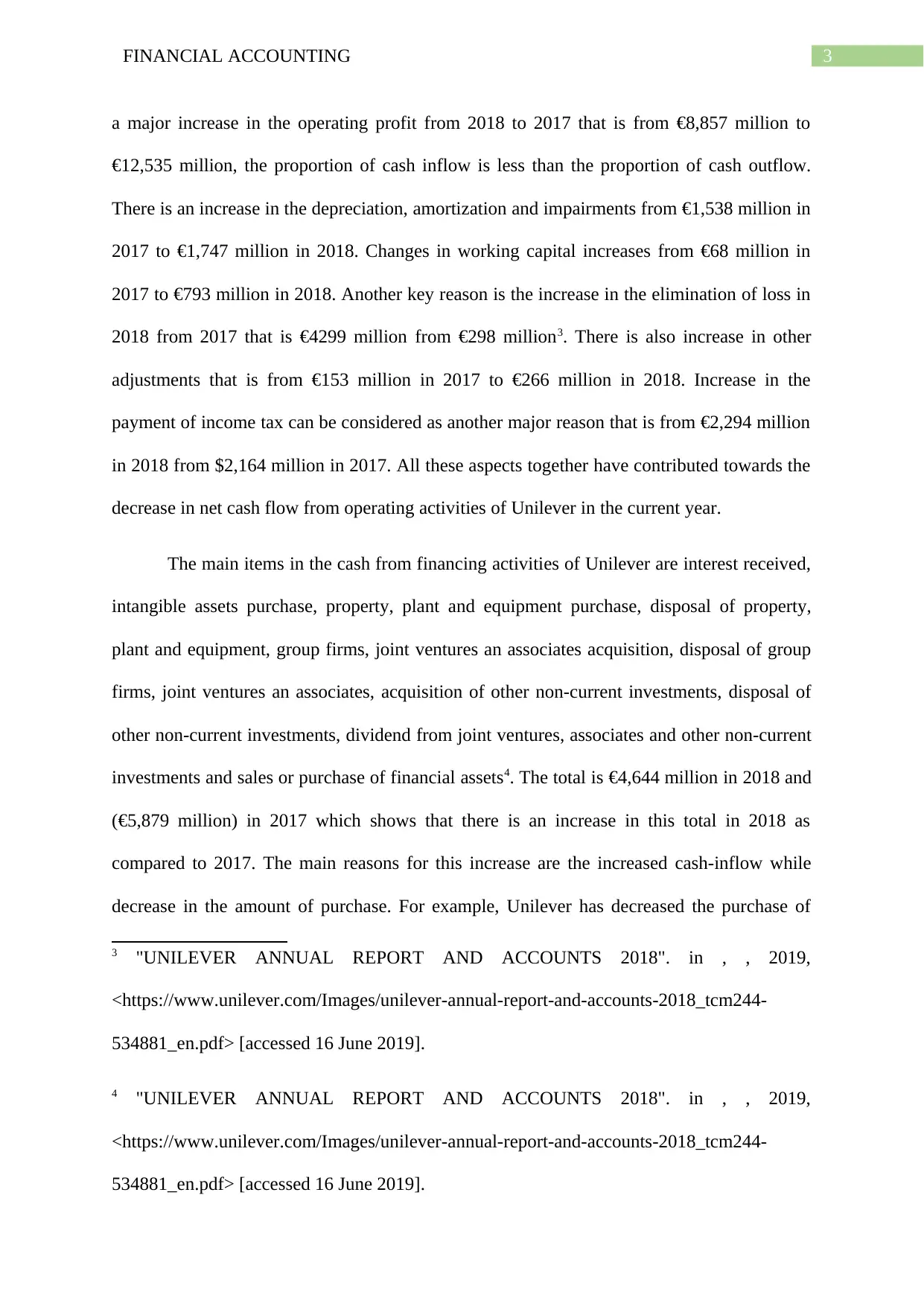
3FINANCIAL ACCOUNTING
a major increase in the operating profit from 2018 to 2017 that is from €8,857 million to
€12,535 million, the proportion of cash inflow is less than the proportion of cash outflow.
There is an increase in the depreciation, amortization and impairments from €1,538 million in
2017 to €1,747 million in 2018. Changes in working capital increases from €68 million in
2017 to €793 million in 2018. Another key reason is the increase in the elimination of loss in
2018 from 2017 that is €4299 million from €298 million3. There is also increase in other
adjustments that is from €153 million in 2017 to €266 million in 2018. Increase in the
payment of income tax can be considered as another major reason that is from €2,294 million
in 2018 from $2,164 million in 2017. All these aspects together have contributed towards the
decrease in net cash flow from operating activities of Unilever in the current year.
The main items in the cash from financing activities of Unilever are interest received,
intangible assets purchase, property, plant and equipment purchase, disposal of property,
plant and equipment, group firms, joint ventures an associates acquisition, disposal of group
firms, joint ventures an associates, acquisition of other non-current investments, disposal of
other non-current investments, dividend from joint ventures, associates and other non-current
investments and sales or purchase of financial assets4. The total is €4,644 million in 2018 and
(€5,879 million) in 2017 which shows that there is an increase in this total in 2018 as
compared to 2017. The main reasons for this increase are the increased cash-inflow while
decrease in the amount of purchase. For example, Unilever has decreased the purchase of
3 "UNILEVER ANNUAL REPORT AND ACCOUNTS 2018". in , , 2019,
<https://www.unilever.com/Images/unilever-annual-report-and-accounts-2018_tcm244-
534881_en.pdf> [accessed 16 June 2019].
4 "UNILEVER ANNUAL REPORT AND ACCOUNTS 2018". in , , 2019,
<https://www.unilever.com/Images/unilever-annual-report-and-accounts-2018_tcm244-
534881_en.pdf> [accessed 16 June 2019].
a major increase in the operating profit from 2018 to 2017 that is from €8,857 million to
€12,535 million, the proportion of cash inflow is less than the proportion of cash outflow.
There is an increase in the depreciation, amortization and impairments from €1,538 million in
2017 to €1,747 million in 2018. Changes in working capital increases from €68 million in
2017 to €793 million in 2018. Another key reason is the increase in the elimination of loss in
2018 from 2017 that is €4299 million from €298 million3. There is also increase in other
adjustments that is from €153 million in 2017 to €266 million in 2018. Increase in the
payment of income tax can be considered as another major reason that is from €2,294 million
in 2018 from $2,164 million in 2017. All these aspects together have contributed towards the
decrease in net cash flow from operating activities of Unilever in the current year.
The main items in the cash from financing activities of Unilever are interest received,
intangible assets purchase, property, plant and equipment purchase, disposal of property,
plant and equipment, group firms, joint ventures an associates acquisition, disposal of group
firms, joint ventures an associates, acquisition of other non-current investments, disposal of
other non-current investments, dividend from joint ventures, associates and other non-current
investments and sales or purchase of financial assets4. The total is €4,644 million in 2018 and
(€5,879 million) in 2017 which shows that there is an increase in this total in 2018 as
compared to 2017. The main reasons for this increase are the increased cash-inflow while
decrease in the amount of purchase. For example, Unilever has decreased the purchase of
3 "UNILEVER ANNUAL REPORT AND ACCOUNTS 2018". in , , 2019,
<https://www.unilever.com/Images/unilever-annual-report-and-accounts-2018_tcm244-
534881_en.pdf> [accessed 16 June 2019].
4 "UNILEVER ANNUAL REPORT AND ACCOUNTS 2018". in , , 2019,
<https://www.unilever.com/Images/unilever-annual-report-and-accounts-2018_tcm244-
534881_en.pdf> [accessed 16 June 2019].
Paraphrase This Document
Need a fresh take? Get an instant paraphrase of this document with our AI Paraphraser

4FINANCIAL ACCOUNTING
property, plant and equipment in 2018 from 2017 that is from €1,509 million to €1,329
million. The same can be seen in case of the acquisition of group companies, joint ventures
and associates which has decreased to €1,336 in 2018 million from €4,896 million in 20175.
There is also reduction in the cash outflows due to the acquisition of non-current investment
and purchase of financial assets. At the same time, increase in cash-inflows can also be seen
in the current year. There is a major increase in the disposal of group companies, joint
ventures and associates that is €7,093 million in 2018 and €561 million in 2017. Same as,
increase in can be seen in disposal of property, plant and equipment and dividend from joint
ventures, associates and other non-current investments. These aspects together have led to
increase in the total.
The main items in the cash flow from financing activities of Unilever are payment of
dividend on ordinary shares, payment of interest and preferred dividend, net change in short-
term borrowings, additional financial liabilities, repayment of financial liabilities, capital
element of financial lease rental payments, preference share buyback, share repurchase, other
movements on treasury shares and other financing activities. There is an increase in the net
cash used in financing activities of Unilever in 2018 from 2017 that is (€11,548 million) in
2018 from (€1,433 million) in 2017. Excessive cash used in the financing activities is the
main reason behind the increase in this total. For instance, there is an increase in dividend
payment on ordinary shares that is from €3,916 million in 2017 from €4,066 million in 2018.
The same can also be seen in case of interest and preference dividend payment that is from
€470 million in 2017 to €477 million in 2018. Net change in short-term borrowings has
dramatically decreased in the current year that is (€4,026 million) in 2018 from €2,695
5 "UNILEVER ANNUAL REPORT AND ACCOUNTS 2018". in , , 2019,
<https://www.unilever.com/Images/unilever-annual-report-and-accounts-2018_tcm244-
534881_en.pdf> [accessed 16 June 2019].
property, plant and equipment in 2018 from 2017 that is from €1,509 million to €1,329
million. The same can be seen in case of the acquisition of group companies, joint ventures
and associates which has decreased to €1,336 in 2018 million from €4,896 million in 20175.
There is also reduction in the cash outflows due to the acquisition of non-current investment
and purchase of financial assets. At the same time, increase in cash-inflows can also be seen
in the current year. There is a major increase in the disposal of group companies, joint
ventures and associates that is €7,093 million in 2018 and €561 million in 2017. Same as,
increase in can be seen in disposal of property, plant and equipment and dividend from joint
ventures, associates and other non-current investments. These aspects together have led to
increase in the total.
The main items in the cash flow from financing activities of Unilever are payment of
dividend on ordinary shares, payment of interest and preferred dividend, net change in short-
term borrowings, additional financial liabilities, repayment of financial liabilities, capital
element of financial lease rental payments, preference share buyback, share repurchase, other
movements on treasury shares and other financing activities. There is an increase in the net
cash used in financing activities of Unilever in 2018 from 2017 that is (€11,548 million) in
2018 from (€1,433 million) in 2017. Excessive cash used in the financing activities is the
main reason behind the increase in this total. For instance, there is an increase in dividend
payment on ordinary shares that is from €3,916 million in 2017 from €4,066 million in 2018.
The same can also be seen in case of interest and preference dividend payment that is from
€470 million in 2017 to €477 million in 2018. Net change in short-term borrowings has
dramatically decreased in the current year that is (€4,026 million) in 2018 from €2,695
5 "UNILEVER ANNUAL REPORT AND ACCOUNTS 2018". in , , 2019,
<https://www.unilever.com/Images/unilever-annual-report-and-accounts-2018_tcm244-
534881_en.pdf> [accessed 16 June 2019].

5FINANCIAL ACCOUNTING
million in 2017. Unilever has increased the repayment of financial liabilities in 2018 that is
€6,594 million from €2,604 million in 20176. The same can be seen in case of share
repurchase as Unilever has increased repurchase of shares in 2018 that is €6,020 million from
€5,014 million in 2017. Other areas of increased cash outflows are other movements on
treasury shares and other financing activities. These has contributed towards the increase in
the total7.
The amount of cash and cash equivalent at the end of the year of Unilever is €3,090
million in 2018 and $3,169 million in 2017. Thus, it can be observed that there is a decrease
in the total of cash and cash equivalent at the end of the year from 2017 to 2018. The main
reason behind this decrease in total is the increase in net decrease in cash and cash equivalent
that is from €20 million in 2017 to €151 million in 2018. In addition, the cash and cash
equivalent at the beginning of the year in 2018 is less than that of 2017 that is €3,169 million
in 2018 and €3,198 million in 2017. These aspects have led to the decrease in the total of cash
and cash equivalent at the end of the year in 2018 as compared to 20178.
There are certain basic differences between income statement and cash flow
statement. Income statement is considered as a part of financial statement that the companies
use for showing revenue, gains, expenses and losses for a certain accounting period9. On the
other hand, cash flow statement is regarded as another part of financial statement that the
6 "UNILEVER ANNUAL REPORT AND ACCOUNTS 2018". in , , 2019,
<https://www.unilever.com/Images/unilever-annual-report-and-accounts-2018_tcm244-
534881_en.pdf> [accessed 16 June 2019].
7 Young, S, J Cohen, & D Bens, Corporate financial reporting and analysis. in .
8 Savel'eva, M, "Evaluating the quality of cash flow statement of Russian companies.".
in International Accounting, 21, 2018, 1024-1036.
million in 2017. Unilever has increased the repayment of financial liabilities in 2018 that is
€6,594 million from €2,604 million in 20176. The same can be seen in case of share
repurchase as Unilever has increased repurchase of shares in 2018 that is €6,020 million from
€5,014 million in 2017. Other areas of increased cash outflows are other movements on
treasury shares and other financing activities. These has contributed towards the increase in
the total7.
The amount of cash and cash equivalent at the end of the year of Unilever is €3,090
million in 2018 and $3,169 million in 2017. Thus, it can be observed that there is a decrease
in the total of cash and cash equivalent at the end of the year from 2017 to 2018. The main
reason behind this decrease in total is the increase in net decrease in cash and cash equivalent
that is from €20 million in 2017 to €151 million in 2018. In addition, the cash and cash
equivalent at the beginning of the year in 2018 is less than that of 2017 that is €3,169 million
in 2018 and €3,198 million in 2017. These aspects have led to the decrease in the total of cash
and cash equivalent at the end of the year in 2018 as compared to 20178.
There are certain basic differences between income statement and cash flow
statement. Income statement is considered as a part of financial statement that the companies
use for showing revenue, gains, expenses and losses for a certain accounting period9. On the
other hand, cash flow statement is regarded as another part of financial statement that the
6 "UNILEVER ANNUAL REPORT AND ACCOUNTS 2018". in , , 2019,
<https://www.unilever.com/Images/unilever-annual-report-and-accounts-2018_tcm244-
534881_en.pdf> [accessed 16 June 2019].
7 Young, S, J Cohen, & D Bens, Corporate financial reporting and analysis. in .
8 Savel'eva, M, "Evaluating the quality of cash flow statement of Russian companies.".
in International Accounting, 21, 2018, 1024-1036.
⊘ This is a preview!⊘
Do you want full access?
Subscribe today to unlock all pages.

Trusted by 1+ million students worldwide
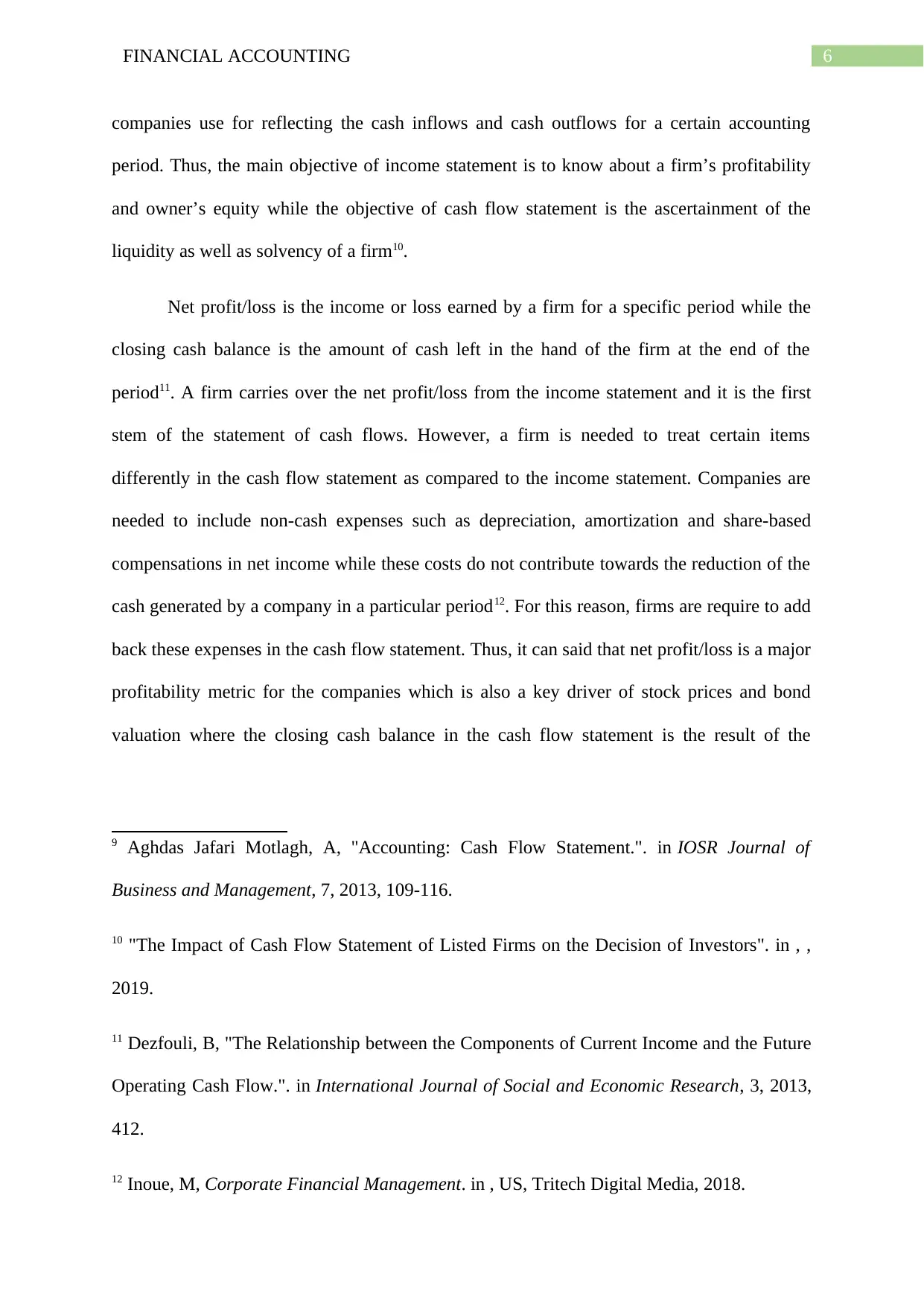
6FINANCIAL ACCOUNTING
companies use for reflecting the cash inflows and cash outflows for a certain accounting
period. Thus, the main objective of income statement is to know about a firm’s profitability
and owner’s equity while the objective of cash flow statement is the ascertainment of the
liquidity as well as solvency of a firm10.
Net profit/loss is the income or loss earned by a firm for a specific period while the
closing cash balance is the amount of cash left in the hand of the firm at the end of the
period11. A firm carries over the net profit/loss from the income statement and it is the first
stem of the statement of cash flows. However, a firm is needed to treat certain items
differently in the cash flow statement as compared to the income statement. Companies are
needed to include non-cash expenses such as depreciation, amortization and share-based
compensations in net income while these costs do not contribute towards the reduction of the
cash generated by a company in a particular period12. For this reason, firms are require to add
back these expenses in the cash flow statement. Thus, it can said that net profit/loss is a major
profitability metric for the companies which is also a key driver of stock prices and bond
valuation where the closing cash balance in the cash flow statement is the result of the
9 Aghdas Jafari Motlagh, A, "Accounting: Cash Flow Statement.". in IOSR Journal of
Business and Management, 7, 2013, 109-116.
10 "The Impact of Cash Flow Statement of Listed Firms on the Decision of Investors". in , ,
2019.
11 Dezfouli, B, "The Relationship between the Components of Current Income and the Future
Operating Cash Flow.". in International Journal of Social and Economic Research, 3, 2013,
412.
12 Inoue, M, Corporate Financial Management. in , US, Tritech Digital Media, 2018.
companies use for reflecting the cash inflows and cash outflows for a certain accounting
period. Thus, the main objective of income statement is to know about a firm’s profitability
and owner’s equity while the objective of cash flow statement is the ascertainment of the
liquidity as well as solvency of a firm10.
Net profit/loss is the income or loss earned by a firm for a specific period while the
closing cash balance is the amount of cash left in the hand of the firm at the end of the
period11. A firm carries over the net profit/loss from the income statement and it is the first
stem of the statement of cash flows. However, a firm is needed to treat certain items
differently in the cash flow statement as compared to the income statement. Companies are
needed to include non-cash expenses such as depreciation, amortization and share-based
compensations in net income while these costs do not contribute towards the reduction of the
cash generated by a company in a particular period12. For this reason, firms are require to add
back these expenses in the cash flow statement. Thus, it can said that net profit/loss is a major
profitability metric for the companies which is also a key driver of stock prices and bond
valuation where the closing cash balance in the cash flow statement is the result of the
9 Aghdas Jafari Motlagh, A, "Accounting: Cash Flow Statement.". in IOSR Journal of
Business and Management, 7, 2013, 109-116.
10 "The Impact of Cash Flow Statement of Listed Firms on the Decision of Investors". in , ,
2019.
11 Dezfouli, B, "The Relationship between the Components of Current Income and the Future
Operating Cash Flow.". in International Journal of Social and Economic Research, 3, 2013,
412.
12 Inoue, M, Corporate Financial Management. in , US, Tritech Digital Media, 2018.
Paraphrase This Document
Need a fresh take? Get an instant paraphrase of this document with our AI Paraphraser

7FINANCIAL ACCOUNTING
adjustments made on net profit/loss13. Unlike net income, the exclusion of non-cash items like
depreciation and amortization can be seen from the operating cash flow that can
misapprehend the firm’s financial position. For these reasons, difference can be seen between
the net profit/loss in the income statement and the closing cash balance in the cash flow
statement14.
13 Kimmel, P, Accounting. in , New York, Wiley, 2018.
14 Kusuma, H, "The Incremental Information Content of the Cash Flow Statement: An
Australian Empirical Investigation.". in International Journal of Business Administration, 5,
2014.
adjustments made on net profit/loss13. Unlike net income, the exclusion of non-cash items like
depreciation and amortization can be seen from the operating cash flow that can
misapprehend the firm’s financial position. For these reasons, difference can be seen between
the net profit/loss in the income statement and the closing cash balance in the cash flow
statement14.
13 Kimmel, P, Accounting. in , New York, Wiley, 2018.
14 Kusuma, H, "The Incremental Information Content of the Cash Flow Statement: An
Australian Empirical Investigation.". in International Journal of Business Administration, 5,
2014.
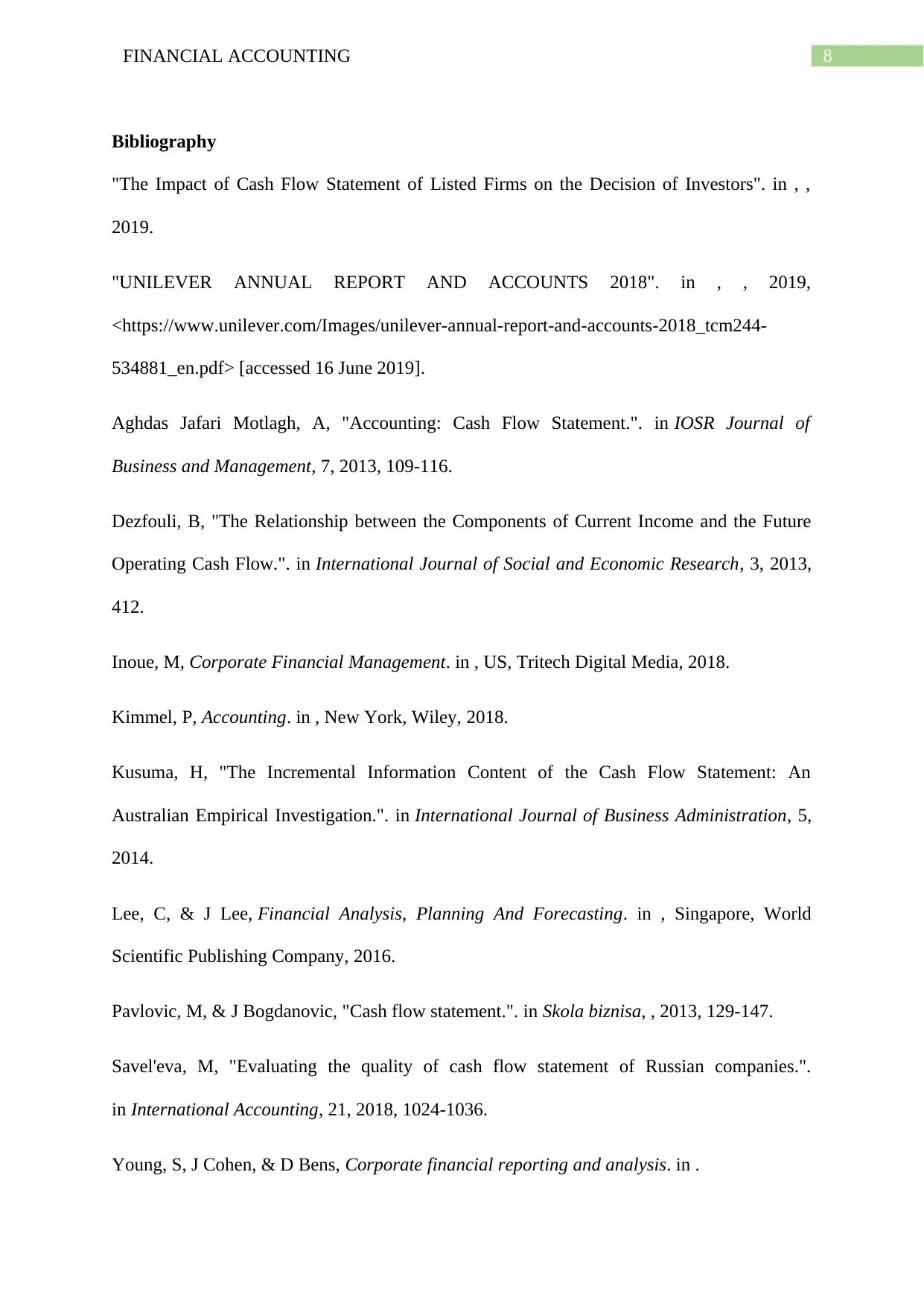
8FINANCIAL ACCOUNTING
Bibliography
"The Impact of Cash Flow Statement of Listed Firms on the Decision of Investors". in , ,
2019.
"UNILEVER ANNUAL REPORT AND ACCOUNTS 2018". in , , 2019,
<https://www.unilever.com/Images/unilever-annual-report-and-accounts-2018_tcm244-
534881_en.pdf> [accessed 16 June 2019].
Aghdas Jafari Motlagh, A, "Accounting: Cash Flow Statement.". in IOSR Journal of
Business and Management, 7, 2013, 109-116.
Dezfouli, B, "The Relationship between the Components of Current Income and the Future
Operating Cash Flow.". in International Journal of Social and Economic Research, 3, 2013,
412.
Inoue, M, Corporate Financial Management. in , US, Tritech Digital Media, 2018.
Kimmel, P, Accounting. in , New York, Wiley, 2018.
Kusuma, H, "The Incremental Information Content of the Cash Flow Statement: An
Australian Empirical Investigation.". in International Journal of Business Administration, 5,
2014.
Lee, C, & J Lee, Financial Analysis, Planning And Forecasting. in , Singapore, World
Scientific Publishing Company, 2016.
Pavlovic, M, & J Bogdanovic, "Cash flow statement.". in Skola biznisa, , 2013, 129-147.
Savel'eva, M, "Evaluating the quality of cash flow statement of Russian companies.".
in International Accounting, 21, 2018, 1024-1036.
Young, S, J Cohen, & D Bens, Corporate financial reporting and analysis. in .
Bibliography
"The Impact of Cash Flow Statement of Listed Firms on the Decision of Investors". in , ,
2019.
"UNILEVER ANNUAL REPORT AND ACCOUNTS 2018". in , , 2019,
<https://www.unilever.com/Images/unilever-annual-report-and-accounts-2018_tcm244-
534881_en.pdf> [accessed 16 June 2019].
Aghdas Jafari Motlagh, A, "Accounting: Cash Flow Statement.". in IOSR Journal of
Business and Management, 7, 2013, 109-116.
Dezfouli, B, "The Relationship between the Components of Current Income and the Future
Operating Cash Flow.". in International Journal of Social and Economic Research, 3, 2013,
412.
Inoue, M, Corporate Financial Management. in , US, Tritech Digital Media, 2018.
Kimmel, P, Accounting. in , New York, Wiley, 2018.
Kusuma, H, "The Incremental Information Content of the Cash Flow Statement: An
Australian Empirical Investigation.". in International Journal of Business Administration, 5,
2014.
Lee, C, & J Lee, Financial Analysis, Planning And Forecasting. in , Singapore, World
Scientific Publishing Company, 2016.
Pavlovic, M, & J Bogdanovic, "Cash flow statement.". in Skola biznisa, , 2013, 129-147.
Savel'eva, M, "Evaluating the quality of cash flow statement of Russian companies.".
in International Accounting, 21, 2018, 1024-1036.
Young, S, J Cohen, & D Bens, Corporate financial reporting and analysis. in .
⊘ This is a preview!⊘
Do you want full access?
Subscribe today to unlock all pages.

Trusted by 1+ million students worldwide
1 out of 9
Related Documents
Your All-in-One AI-Powered Toolkit for Academic Success.
+13062052269
info@desklib.com
Available 24*7 on WhatsApp / Email
![[object Object]](/_next/static/media/star-bottom.7253800d.svg)
Unlock your academic potential
Copyright © 2020–2025 A2Z Services. All Rights Reserved. Developed and managed by ZUCOL.





